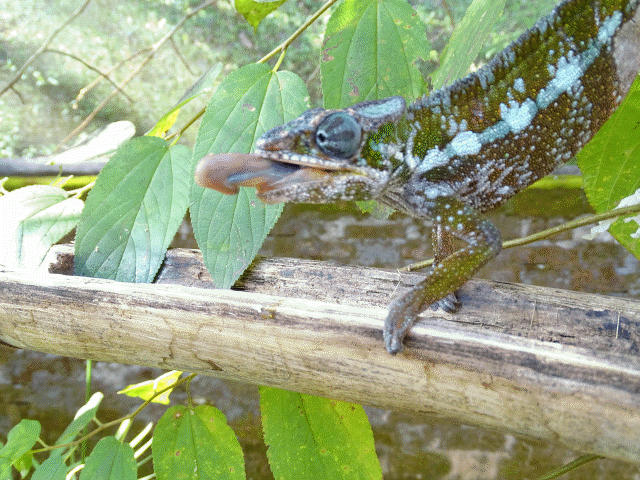Have you ever wondered how chameleons are able to shoot out their tongues, grab a snack, and bring it back to their mouths? That skill is all thanks to the chameleon tongue’s unique mix of special muscles. Their ability to use their tongue for grocery shopping is essential for their survival, and the way it works is fascinating!
Apart from the famous color-changing skin chameleons have, they possess a magnificent power within their mouths. The chameleon tongue sits loaded in the mouth, always ready to attack the prey. When ready to shoot, they push their tongue against a bone inside of their mouth, which throws the tongue forward at a rate of up to 50 milliseconds, according to The Elastic Secrets of the Chameleon Tongue by Derek E. Moulton – that is less than a tenth of a second! This pushing off is similar to needing starter blocks in track to have an explosive start. After being shot out, the tongue separates into sections that lengthen telescopically, like the well known toy lightsabers (Moulton, 2016). These sections are referred to as sheaths, and they are said to contain all of the potential energy needed to shoot the tongue out so far (Moulton, 2016). Before launch, the sheaths look like concentric cylinders stacked together – think of cutting a jawbreaker in half and seeing all of the layers of circles, except there are only a few, large layers. Once the tongue has been released, it can reach up to 2.5 times the length of the body of the chameleon (Moulton, 2016)! In order to actually get a grip on the prey, the tongue is equipped with a type of sticky pad, as claimed by Peter C. Wainwright in The Mechanism of Tongue Projection in Chameleons: I. Electromyographic Tests of Functional Hypotheses. After the prey is caught (or missed), it takes a little bit longer for the chameleon to bring its tongue back into its mouth (Moulton, 2016). This type of retraction can be found in other nature, such as an elephant’s trunk (Moulton, 2016).
Chameleons eat all kinds of insects, such as crickets, grasshoppers, and if the chameleon is large enough, sometimes even small birds (San Diego Zoo, 2024). What if the prey is unusually large or heavy, though? How can a tongue carry that load back into its mouth? The chameleon tongue is made up of various extraordinary muscles. Take a moment and think about how a chameleon would go about hunting its prey; it tries its best to blend into its surroundings, and after waiting for the prey to come near, it strikes quickly with its killer tongue. In order to have such a fast strike, the chameleon first uses the special muscles in its tongue, called hyoglossus muscles (found in many animals), and then applies the accelerator muscle to push its tongue out (Wainwright, 1992). These hyoglossus muscles help to push against the bone that was mentioned above. Then, the retraction muscles are utilized, and the hyoglossus continue working (Wainwright, 1992). The retractor muscles can be thought of as the accordion part of a bungee cord; they can be stretched out and bounce back to a shorter length. Those muscles are said to have “evolved supercontractile properties” that allow the chameleon to pull its prey in from various distances, according to Functional Implications of Supercontracting Muscle in the Chameleon Tongue Retractors by Anthony Herrel. After a bit of a workout, the chameleon then has a tasty meal to enjoy, that is, if it has good aim!
Featured Image from Pixabay

